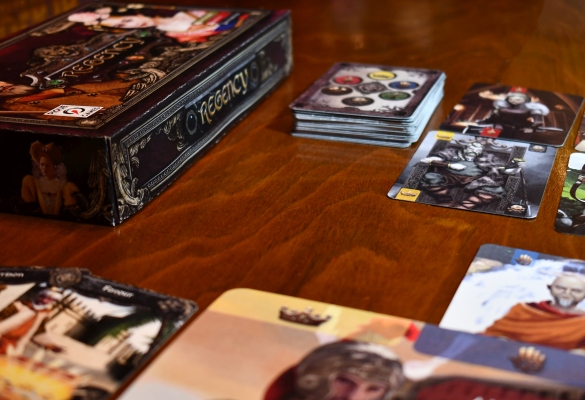
Exert Your Influence in Regency
Designer: James Fazio
Artist: Peter Zalba, Rieno Monterona, Susanna Saar
Publisher: Pique Games
Year Published or Kickstarted: September 2020
No. of Players: 2-6
Ages: 10+
Playing Time: 20-40 Minutes
Main mechanic / Theme: Tableau building, influence
Find more info on BoardGameGeek.com.
Find Regency on Kickstarter HERE.
"A gem of a game you should keep in your bag of holding!"
Overview:
Regency is a card game wherein players compete as well-known rulers of the world to exert influence upon citizens to create the greatest fiefdom. The heart of the game lies in the actions and reactions of the players as each tries to gather the citizen cards - one card from each caste- to become the greatest regent. But, beware, as other regents can exert their influence. The event cards are used to move citizens between players’ fiefdoms. You must always be on the lookout in order to build your fiefdom and claim the supreme regency before another regent influences them to their fiefdom.
Gameplay and mechanics:
Regency is a card management, influence game where players use a hand of four cards to affect and change the game state. The event cards in hand are used to move citizens to and from other player’s tableau, while at the same time they can alternatively be used to attract citizens from the populace (the row of three citizen cards in the populace) to their fiefdom. Each player picks a leader or ruler from history which has a specific prowess related to one of the six castes that the citizens belong to. To use the specific powers on some event cards, players must have a citizen in their tableau that matches the caste on the event card, or the appropriate prowess. Players can not play an event card without that matching caste or prowess.
The decision-making happens as you decide to attract citizens to your fiefdom (player mat) or use the cards as events to move citizens around. This movement typically messes with the other players and they may react to the events played if they have appropriate reaction cards. Sometimes you have to make an interesting choice- do you use the event card to influence the populace to come to your fiefdom or should you use the event card now, or save it for the next round?
The game plays better with more players as you have more options to play events to affect different players. With only two or three players, your choices are limited on whose tableau you are going to affect. Although, having fewer players doesn’t mean the game is any less enjoyable, it just means you have fewer choices in how your event cards interact with the other players.
Gameplay is not difficult, but it is interesting as you try to manage your cards in hand and how you want to influence the game- either through events or attracting populace cards to your fiefdom. Sometimes the simplest of gameplay provides more rewarding choices than more complex games.

Theme, Artwork and Illustration, Graphic Design and Layout:
The production quality in regard to artwork, illustration and the design layout is top notch. Because the icons are easy to read and the castes types on each citizen card are at an expected location on the cards, players will learn where the few bits of information are located, speeding up game play.
As players choose specific historical world leader mats, the artwork should match that time period and historical persona, and it does. The artwork is well-done and none of the images are dark or blurry. The theme for each historical figure is brought out by the character illustration and you can easily see where that persona fits, geographically, in the world. I think those who had a hand in development understood the importance of pushing theme in the game as well as the user-friendliness for ease of game play.
All of the images across the card types and player mats are in the same style and vein bringing all of the components together into a cohesive theme. As a player, I did catch myself looking at the artwork as new cards were drawn to my hand instead of focusing on game play.

What worked:
As a player, the most interesting thing within the game was making the decisions between using the event cards as actual events or saving them for influence to bring new populace cards to my fiefdom. The rotating cards in the populace also proved to work well- only allowing you to influence the three in the bottom row but at the same the three cards in the top row provide reference as to what cards will be coming available later in the game.
What can be improved:
Game play is pretty straightforward and there isn’t much that can be improved. The game plays well for what it is- It’s not meant to be an in-depth multi-hour-long game and Regency doesn’t try to be. There are no new or innovative mechanics, but that doesn’t lessen the enjoyment, although, in today’s context of modern gaming there typically needs to be something unique to a game to let it rise above the masses.

Final thoughts:
Regency is a fun and clever game. Pique Games is an indie publisher and will continue to build their catalog on the success of Regency. It is a game that I can see coming to the table multiple times as players want to get back at their friends for beating them or reacting to an event they played. One caveat- There is some take-that in the game and if your game group doesn’t enjoy those types of games or you have a player that can’t handle a little take-that, I’d recommend avoiding this game with those groups or players. Otherwise, this is a gem you should look at backing and supporting. You can’t go wrong.

